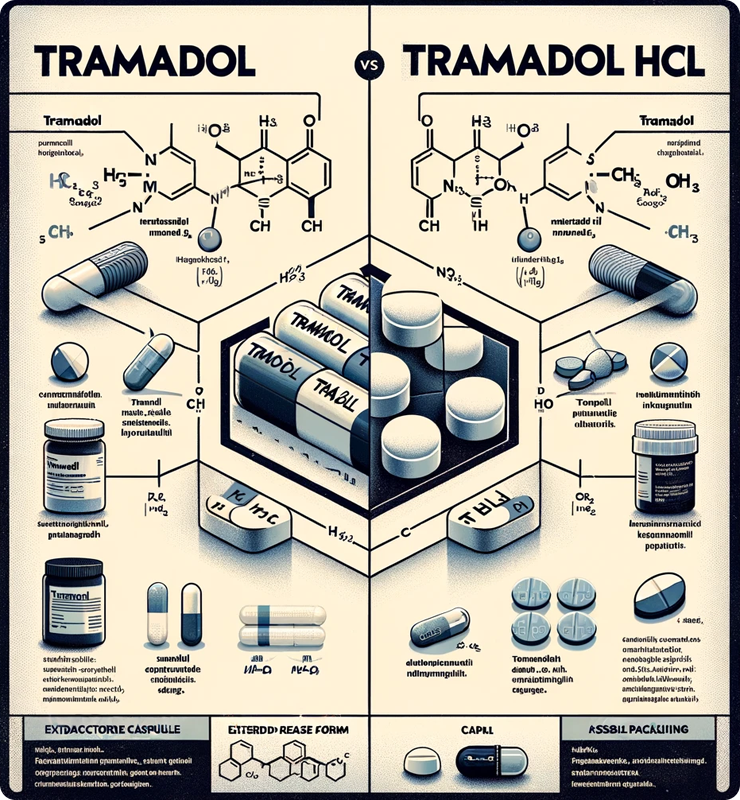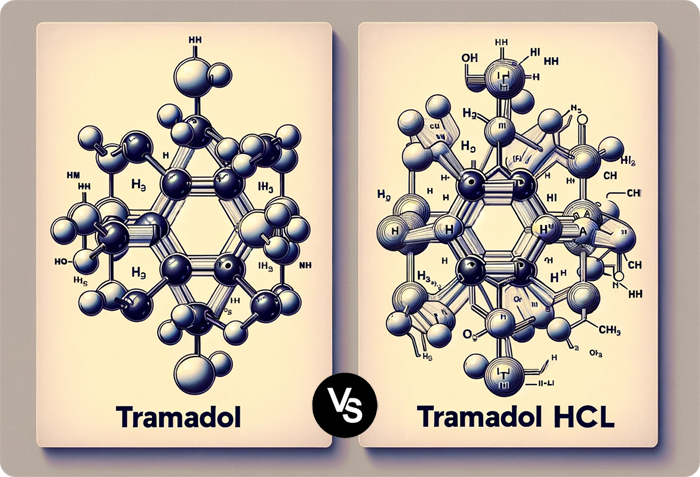

Differences Between Tramadol and Tramadol HCL
Tramadol and Tramadol HCL (Hydrochloride) are two forms of the same medication used for the relief of moderate to severe pain. While essentially the same substance, there are minor chemical differences between them.
Tramadol
Tramadol is the primary active ingredient, an opioid analgesic, which works by affecting certain parts of the brain and nervous system to reduce the sensation of pain. It diminishes pain sensations by influencing the brain's ability to perceive pain.
Tramadol Hydrochloride (HCL)
Tramadol HCL is the hydrochloride salt form of Tramadol. This version is created by combining Tramadol with hydrochloric acid, resulting in a substance that is more stable and soluble in water. The hydrochloride addition is a common practice in pharmaceuticals to enhance a drug's stability, bioavailability, or absorption in the human body.
Key Differences
- Chemical Composition: Tramadol HCL has an added hydrochloride group, improving its solubility and stability.
- Usage: Both are used for pain relief, but Tramadol HCL's improved solubility makes it more suitable for oral consumption and injections.
- Effectiveness: The addition of hydrochloride does not significantly alter the effectiveness of Tramadol in pain relief.

Tramadol vs Tramadol HCL Release Forms
Tramadol and Tramadol HCL (hydrochloride) are available in various release forms, however, the difference between them is usually minor and mainly related to their chemical composition and solubility. Here is a general comparison:
Tramadol
- Oral Tablets and Capsules: Available in both immediate and extended-release forms. Often used for continuous pain control.
- Solutions and Injections: Used in clinical settings for quick pain relief.
- Oral Drops: Suitable for patients who have difficulty swallowing solid forms of medication.
- Suppositories (Rectal Use): Used when oral administration is not possible or effective.
Tramadol HCL
- Oral Tablets and Capsules: Similar to Tramadol, available in immediate and extended-release forms. Better solubility in water may improve absorption.
- Solutions and Injections: Also used for rapid pain relief in medical institutions.
- Oral Drops: Also available, similar to regular Tramadol.
- Suppositories: Similar to Tramadol but may provide better absorption due to the chemical properties of HCL.
Differences
- Chemical Composition: The main difference between Tramadol and Tramadol HCL lies in the addition of the hydrochloride group in the latter, improving its solubility and stability.
- Absorption and Bioavailability: Although both forms are effective for pain relief, Tramadol HCL may have better bioavailability due to improved solubility.
- Release Forms: In general, the release forms of both versions are similar, but may vary slightly depending on the manufacturer and patient preferences.

Tramadol VS Tramadol HCL Price Difference
The price difference between Tramadol and Tramadol HCL (Hydrochloride) can vary based on several factors, including the dosage, form of the medication (such as tablet, capsule, or liquid), the quantity purchased, brand versus generic versions, and the region or country where it's being sold. Additionally, prices can be influenced by insurance coverage and pharmacy pricing policies.
The cost for Tramadol oral tablet 50 mg in the USA is around $6 for a supply of 30 tablets, depending on the pharmacy you visit. These prices are for cash-paying customers and are not valid with insurance plans. The price can vary for different quantities of tablets, with per unit prices ranging from about $0.21 to $0.40.
For Tramadol HCL (Hydrochloride), the average retail price is approximately $32.75 for 30, 50mg tablets. However, with the use of coupons like those from SingleCare, the price can be reduced to around $6.32 for 30, 50mg tablets. Please note that these prices may vary and it's always best to check with local pharmacies for the most accurate and current pricing.
Why Was Tramadol HCL Developed?
The formulation of Tramadol HCL (hydrochloride) was developed for several reasons:
- Improved Solubility: The hydrochloride enhances Tramadol's solubility in water, improving its absorption in the body. This is crucial for achieving a more stable and predictable therapeutic effect.
- Stability: The hydrochloride form offers greater chemical and physical stability, important for the storage and transportation of the medication.
- Bioavailability: Enhanced solubility leads to better bioavailability, ensuring more effective treatment.
- Standardization: Converting Tramadol into its hydrochloride salt allows for standardized dosing and production of the medication.
Overall, these modifications are aimed at improving the efficacy and safety of Tramadol as a pain relief medication.
Choosing Between Tramadol and Tramadol HCL
The choice between Tramadol and Tramadol HCL (hydrochloride) depends on several factors, and the preference for one over the other will vary based on specific circumstances. Here are some key considerations:
- Solubility and Absorption: The response to the medication can vary greatly among individuals. Some patients may respond better to one form of the drug compared to the other.
- Medical Recommendations: A doctor familiar with a patient's medical history and current condition will be able to provide the most suitable recommendations regarding the choice between Tramadol and Tramadol HCL.
- Availability and Cost: In some regions, one form of the drug may be more accessible or economical compared to the other.
- Duration and Regimen of Treatment: For long-term pain management, extended-release forms may be preferable.
Comparative Patient Experiences: Tramadol vs Tramadol HCL
Based on patient reviews and feedback from various sources, the experiences with Tramadol and Tramadol HCL can be quite diverse.
Tramadol has an average rating of 6.9 out of 10, with 61% of reviewers reporting a positive experience, while 24% reported a negative experience Tramadol Hydrochloride ER, which is an extended-release form of Tramadol HCL, has an average rating of 5.5 out of 10, showing a more mixed response with equal percentages of positive and negative experiences reported.
One user expressed gratitude for Tramadol HCL, indicating it worked well for him and considering it a "miracle drug".
However, the experiences can vary widely, with another user describing withdrae 24% reported a negative experience Tramadol Hydrochloride ER, which is an extended-release form of Tramadol HCL, has an average rating of 5.5 out of 10, showing a more mixed response with equal percentages of positive and negative experiences reported.
One user expressed gratitude for Tramadol HCL, indicating it worked well for him and considering it a "miracle drug".
However, the experiences can vary widely, with another user describing withdrawal symptoms after taking Tramadol HCL for over a year for a back injury. Another user reported negative side effects like dizziness and nausea after taking Tramadol HCL alongside another medication.
Individual responses to medication can vary greatly based on a variety of factors including personal health conditions, usage patterns, and other medications being taken. Both Tramadol and Tramadol HCL are the same medication in terms of their active ingredient, but the hydrochloride salt form (HCL) is more commonly used due to its improved solubility and stability, which may affect absorption and the onset of action.
Clinical Considerations
When prescribed Tramadol, it is typically in the form of Tramadol HCL due to its enhanced properties. However, it's important to follow the prescribed dosage and be aware of potential risks such as dependency, as it is an opioid.
While Tramadol and Tramadol HCL are chemically different, in the context of pain treatment, they are considered interchangeable, and the choice between them often depends on the form of medication and manufacturer preferences.